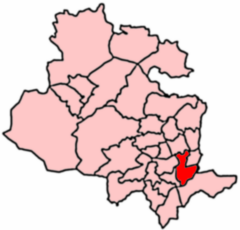East Bowling
| Bowling and Barkerend | |
|---|---|
 2004 Boundaries of Bowling and Barkerend Ward |
|
| Councillors |
|
East Bowling is an area of Bradford, West Yorkshire, England located to the south of Bradford city centre. It forms the eastern half of the historic township and manor of Bowling. Bowling became a ward of the newly created Borough of Bradford in 1847. In 1882 the ward was split into the wards of East and West Bowling. In the north the boundary was along the Lancashire and Yorkshire Railway. To the south it was along Hall Lane and Bolling Hall Lane.
The southern/southeastern boundary follows Rooley Lane and Sticker Lane. The northern boundary follows Bowling Back Lane. East Bowling forms a roughly triangular area with its southern apex near Croft Street about 350m from the city centre. Wakefield Road is its main thoroughfare.
East Bowling is now a part of the Bowling and Barkerend ward
William Cudworth published his "History of Bowling" in 1891. The opening sentence sets out his difficulty. "In attempting an historical and topographical sketch of the township of Bowling, we are confronted with a .. difficulty .. namely, that no published record previously existed upon which to base our efforts". Cudworth triumphed over the difficulty. Although subsequent authors have added greater detail his account has never been bettered. It is the main source of information for this section.
The township contained 1561 acres. The total acreage of the borough of Bradford at that time was 10,776. Cudworth describes the small becks which drain the area (see Map 1) noting that some do not have definite names. John James in his history of Bradford (1841) has to refer to " a nameless beck arising to the west of Dudley Hill" - which is shown in Map 3 contributing water to the Lady Well Pool. This, Bowling Beck and Law Beck (also known as Claw Beck and Low Beck) had leets which sent their water to the Bowling (manorial) corn Mills - which were nevertheless often stopped by shortage of water.
In the north Bowling came within a few hundred yards of the centre of Bradford. This was the lowest point of the township at an altitude of about 360 feet above sea level. To the south the township boundary followed the watershed between Bradford Dale (draining to the north) and tributaries of the Aire and Calder draining to the south and south west. Map 1 shows that the watershed was at an altitude of 600 feet at Laisterdyke (in the east) rising to 700 feet at Odsal Top.
Most of Bowling was above the 500 ft contour and much of it above the 600 ft contour. The soil cover was boulder clay, unsuitable for arable farming. Altitude and poor soil limited the available crops. Little wheat could be grown. Grains were either barley or oats. Cudworth could find scant evidence that the "three open field" system had ever been used in Bowling, though it was a major feature of Bradford, Manningham and Horton. Outside of the parks of Bowling Hall the land was divided into small walled closes in pastoral use, a pattern which had prevailed since ancient times. There was no common land in Bowling, and there had never been an enclosure act.
...
Wikipedia
